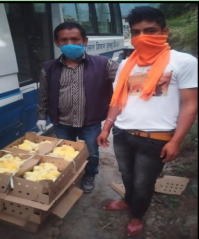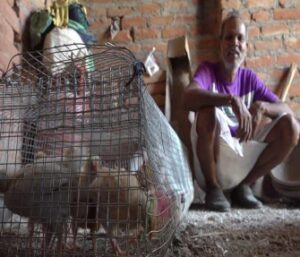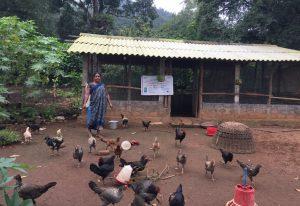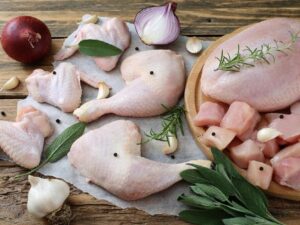Profitable Poultry Farming Practices
Dr. Sonale Nagesh1*, Dr. Prashant Patel1, Dr. Monika M1., Dr. Rokade J.J1., Sky2, Asawaree Hable3 Dr. Shruthy R1.
1ICAR- Central Avian Research institute and Technology, UP, Bareilly, India.
2Khandelwal College of Management Science and Technology, UP, Bareilly, India
3MAEER’s MIP, MH India,
Corresponding author: dr.nssonale@gmail.com
Introduction
Poultry farming is a scientific management approach that necessitates some kind of systematic methodology for raising poultry birds either broiler or layer. It requires a variety of resources, including land, feed, infrastructure/healthy housing, water and feed equipment, labour, vaccine, medicine, ventilation, lighting, litter, and so on. Aside from raising commercial layers and broilers, poultry rearing also involves diversified poultry production, which deals with different kinds of avian species. The poultry species included in this are geese, pigeon, pet birds, ostrich, and emu, recently diversified poultry farming is becoming more popular which helps in income generation for poultry farmers during the year. Also provides the way forward to the Prime Minister’s motive of increasing two-fold of the farmer’s income. (The Hindu- 20 June 2018) The poultry industry is classified as the fastest growing sub-sectors of Indian agriculture today, and the growth rates of egg and broiler production are around 6% per annum. The gauge output from the poultry sector accounts for about 1% of India’s GDP and 12% of GDP from the livestock sector, The organized poultry sector contributes nearly 80% of the total output and the rest to the unorganized sector. Within the poultry sector, 2/3rd of the output (about 66.7%) is contributed by the poultry meat sector and the rest 1/3rd (about 33.3%) is from egg production. This indicates that broiler production has been more vibrant than layer production in terms of annual growth. The poultry sector is employing more than 6 million people, 3 million directly and another 3 million indirectly. About 80 % of the straightforward capacity building/ employment is generated by poultry farms, while the rest is generated by the feed, pharmaceutical, equipment manufacturing units, and other services required by poultry. Another 3 million people are getting employment indirectly in several supporting activities. It is estimated that an increase in the per capita availability of one egg will generate 50,000 more jobs. (Chatterjee, et al., 2015).
Though India has the tropical condition as well as climatic variations in different parts of the country but still due to several factors such as integrating participants and significant investment in breeding, hatching, rearing, and processing operations, it has morphed from a typical backyard farming into a full-fledged commercial sector and achieved exceptional position compared to all developing countries in poultry Industry. Government statistics show that egg production has been increasing steadily, going from 95 billion in 2017–18 to 105 billion the next year, and then to 114 billion in 2019–20. Similarly, poultry meat production, too, has been expanding from 3.7 ml t in 2017-18 it grew to 4.1 million tons the following year, and then on to 4.3 million tons in 2019-20. (The Hindu-Business lines Report -15th Aug 2022). In the global market of poultry, India stands – 7th in poultry production with a population of 791 million birds. Indian poultry market become one of the foremost countries in the world with leading in 3rd (122 billion kg ) rank in Egg production and 5th rank (4.3 billion ) in meat production (FAO stat-2020, DADF, annual report2021-2022).
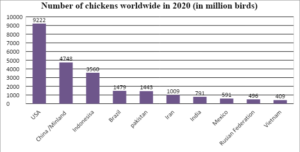
Source : The global number of chickens by country 2020 | Statista
Poultry businesses are keen on getting better marginal profit value from their farms by increasing yields, selling eggs, meat, and other associated items such as feathers, jute bags, and poultry litter, among others. If any sort of farming, including poultry, is to be lucrative, certain operating rules must be followed; nevertheless, if farm authorities disregard these principles, substantial losses will result.
The production costs of the poultry industry in India differ from region to region, the majority of production is still carried out by independent and relatively small-scale producers, although in some places, particularly in the broiler industry, relatively large-scale integrated producers are taking a larger proportion of the market. Large regional enterprises that encompass all facets of production, such as rearing day-old chicks, contracting production, compounding feed, offering veterinary services, and wholesaling, are examples of integrated operations. The south and west are the two regions with the highest concentration of large-scale integrated manufacturers. In the northern and eastern regions, the majority of poultry is produced by smaller, independent, and occasionally partially integrated producers.
Benefits of Poultry Farming Business:
1.Best Agro-allied business
Boost up family income for better utilization of family labours who are not able to perform other Agri works like old members or children of the family. any backyard or open space land can be used for desi rearing. Feed cost is negligible due to better utilization of agricultural by-products or leftover feed & grains in case of desi rearing at backyard level or village poultry farming
2.Less capital investment needed:
One of the primary advantages of raising poultry is that it doesn’t start with a large initial investment. To begin farming poultry, you only need a small amount of capital. It has a low initial investment with a higher economic return, a unit can be started with as low as 100 to 1000 broiler birds, and in the case of desi birds minimum of 5 to 20 birds.
3.No need for enormous space:
Unless you plan to start your poultry farming business commercially, a big space is not necessary. With one or more coops or cages, you can raise some birds in your backyard with ease. So, if you’re interested in raising poultry, you can easily do so in your backyard with a variety of birds.
4.Penny cash flow for economically weaker section of society
In India, for economically weaker sections such as tribal, and socially backward class people income upliftment can be possible by providing them small no of poultry birds this will be a small piggy bank for them. Consumers are willing to pay higher prices for the desi/ backyard chicken meat or eggs.
5.High returns in a short time:
It’s interesting to note that the commercial poultry farming industry guarantees a high return on investment in a very short amount of time. Few poultry birds such as broiler chickens take a shorter duration of time to mature and generate profit. Monetary returning time is very less compared to all other livestock businesses. i.e. approx 23 to 40 days it seems like the monthly salary for broiler farmers in the case of other birds may vary or maybe more than 6 months. Poultry products are not much expensive. It can be afforded by most people. It has higher profit marine depending upon various festival celebration.
6.No high maintenance required:
High Maintenance is not needed: The buildings used for chicken farms do not need high maintenance. Furthermore, by practicing adequate hygiene and care, you can reduce illnesses and infections in poultry. Some poultry birds, including quails and turkeys, are less prone to disease.
7.License not compulsory:
It must be noted that, in most cases, you don’t need any license. As almost all types of poultry birds are domestic. Also getting the license from the relevant authority is easy for poultry.
8.Huge global demand:
Poultry gives you fresh and nutritious food and has a huge global demand. Therefore, global consumers of poultry products prefer them due to their nutrients and freshness. As the population is increasing drastically for maintaining demand supply flow smoothly scientists developed different strains of chicken performing better in terms of growth as well as egg production.
9.Easy marketing:
Marketing poultry products is very easy. There is an established market for poultry products in almost all places of the world. So you can easily sell the products in your nearest local market.
10.Huge income & employment Opportunities:
Poultry farming creates income and employment opportunities. Unemployed educated youth can easily make a great income by raising poultry commercially. Women and students can also do this business.
11.Easy Bank Loans:
Almost all banks approve loans for these types of business ventures. So, if you want to start this business commercially, then you can apply for loans from your local banks. Almost all the top banks in India provide loans for poultry farming.
Different types of Poultry farming & profit margin
Commercial poultry Farming
1.Broiler Farming:
Commercial broiler poultry farming is a very popular and profitable business. Broilers are reared under confined sheds on the floor i.e., on deep litter up to attaining the marketable age (35 to 42days). Broilers are straight-run birds it is reared by both sexes, particularly for meat purpose. Nowadays after a lot of genetic modification done by poultry scientists, we can able to get the standard marketing weight of broiler birds are 2.3- 2.5 kg in 40 days achieving FCR 1.5- 1.7, They can produce about two kg of meat by consuming about 4.25 kg of feed during their entire growth period. Scientific Management should be very good and keen on the case of poultry farming for achieving a profitable business margin. The main focus should be given during brooding on the main goal of minimizing mortality during the early stage, and maximum daily weight gain. Commercial broiler farming can be done either individually or by contract framing by giving a farm to the company for lease with some formalities on a particular period. With the best management, and maintenance hygiene practices in one year time period 6 batches of the broiler can be produced, broiler farming’s maximum profit can be achieved by implementing the following Key factors.
- Proper management during brooding
- Minimizing mortality during the initial chick stage
- Maintaining the highest daily weight gain by providing quality feed according to different stages.
- Temperature and humidity should be maintained according to given standards. (40degree Celsius temp and R.H. >65%)
- Feed contribute 70% and which is a major part whose inclusion can be manipulated by using different non-conventional feedstuff.
Commercially available broiler strains are Cobb, Hubbard, Ross, aveebro, Sunbro, etc.
India broiler meat producing leaders’ states are located mainly in the southern region of India in which Tamil Nadu stands 1st followed by Andhra Pradesh, Telangana, West Bengal, and Maharashtra.
Contract broiler farming
In India, there are so many big integrators who are playing a major role in increasing the broiler population. In that, those integrator gives birds, feeds, vaccine, medicine, and all facility required for rearing poultry birds in return they give some monetary refund to poultry farmer in terms of growing charge. In recent years most farmers are preferring rearing birds in contract farming because they get benefits through this with minimum investment. The farmer who does contract farming gets a growing charge based on some parameters such as production parameters which include body weight, feed consumption, FCR, mortality, EEF, and daily weight gain. In some companies normally growing charge is mainly focused on FCR. How much better FCR is to get that much amount of money reimbursed by the integrator? Now recent Growing charges given to farmers are between Rs. 6 to 11 depending upon their performance.
The benefit of contract broiler farming
- No huge initial investment
- There is an assured return to farmers
- Need not worry about the market situation
- Need not tother about health care
Apart from this, some people rear broiler birds as an individual, in this farmer, invest in all aspect such as land, infrastructure, chick, feed, vaccine, medication, etc. in this farming farmer is the whole sole owner of the farm and profit share is gained by a farmer only but there are chances of market collapsing during that time losses threat will be more predominant.
Profit margin in broiler farming is very high and that depends on the market demand and supply, sometimes some festivals also impact chicken rates such as Navratri, Ganesh Chaturthi, and Savan month in which most non-vegetarian people won’t prefer chicken consumption. But same time during some festivals time people prefer more chicken such as Christmas, Holi, etc, prices of chicken show a great hike during this time, and that can be a great opportunity to get maximum profit in broiler farming.
2.Commercial layer Farming:
Raising poultry for egg production commercially is referred to as “layer poultry farming.” Layer hens are a unique breed of hen that must be raised from the time they are one day old. Commercial egg production begins when they are 18 to 19 weeks old. They continue to lay eggs until they are 72–78 weeks old. During their egg-laying cycle, they may consume about 2.25 kg of food and produce roughly 1 kg of eggs, in the initial stage of layer farming care should be taken in all aspects such as feed, water, management, vaccination and medication, initial 1st to 20th week there will not be egg production because the sexual maturity starts at age of 19 to 20 week so that productive period for layer farming is 23 to 48 weeks where peak production given by laying birds. The egg is an unadulterated, rich protein source, and the perishability of the eggs is less, compared to chicken so we can store eggs for more time so that the egg market is stable. The difference in variation in price is not much affected by egg production.
Most people prefer individual layer farming initial investment is higher in this business compared to broiler farming but the advantage of this business is the cash flow is stable, and the profit margin money is also stable. For infrastructure cost per bird is required approximately Rs. 250-300 for caged housing. The egg market is sustainably constant and the profit margin is high if it is implemented in commercial such as rearing 5000 to 10000 birds in cages. The market price of an egg is always nearby 5 to 6 rupees whereas in the wholesale market the price is approximately Rs. 4.6 to 4.9 and the cost of production per egg will depend upon perfect management and high-density nutrition but accounts for about Rs. 3.5 to 4.3 and this may vary and on this different factors are responsible. Though Initial investment is very high in layer farming with the implementation of scientific management farmers can achieve a breakeven point in 5 to 6 years. Presently to fulfilling the demand for eggs so many strains are developed by poultry scientists, to produce hybrid eggs layer, considering the various characteristics of cock and hen before breeding. There are various types of highly egg productive layer breeds now available throughout the world ut in Indian following breeds are very much important for egg production. such as Bovans, Babcock, Lohman, Hyline, etc.
Diversified poultry farming
Ducks, turkeys, Japanese quail, guinea fowl, geese, and pigeons are among the poultry varieties. Other than commercial egg and broiler chicken production, it may also comprise all poultry production methods. Diversified poultry systems are increasingly seen as a sustainable source of income for small and marginal farms. Ducks make up 7% of the poultry population and are most common in coastal regions and those with more lakes and rivers, such as West Bengal, Orissa, Andhra Pradesh, Tamil Nadu, Kerala, Assam, Jammu and Kashmir, and Tripura. Duck farming is still in its early stages, and despite their lower performance, indigenous ducks outnumber alien ducks. Japanese quail farming is a low-cost agricultural method that is showing increasing potential. Farming of turkeys, Guinea fowls, and geese is still in its infancy. Farming of emus and ostriches has also been attempted. Chickens alone account for around 90% of the overall population in India and the world, whereas ducks, geese, guinea fowl, pigeons, and turkeys are insignificant.
1.Country chicken farming / Desi chicken farming
India has long practiced raising desi hens or country chickens. Local, native birds are typically raised in backyard flocks, or open spaces adjacent to the house. Due to desi birds’ modest body weight and high construction capacity, all of our rural birds including Cauvery, Kalinga Brown, Nirbheek, Hitkari Grampriya, and Vanraja are more preferred in semi-intensive types in rural and tribal areas. Desi birds attain their marketable body weight about 10 to 12-week gaining a body weight of 1.3 to 1.8 kg in egg production, they produce 120 to 160 eggs, these production values vary from breed to breed.
Native chicken has undergone a natural selection and is best adapted for the local climatic conditions, they can survive on kitchen and agricultural wastes and survives well on scavenging and leftover feed. They are hardy and resistant to many diseases and can survive well from predators. Native hens have excellent mothering skills and make good brooders capable of self-propagation; they can build their nests, deposit eggs in them, raise their young, and care for them. The benefit of desi poultry farming is a low initial outcome, combined with larger economic returns. The country chicken farm can begin with two birds and progressively expand to a flock. Because of the significant demand for local chicken, the birds and eggs they produce can be sold in the local market regardless of the season. However, native chickens are not very productive, thus it is necessary to raise better varieties of chicken to boost output. Now in different research stations, native chickens are modified by genetic up gradation. For eg. Vanraja, Giriraja, swarnadhara, Gramlaxmi, Atulya etc CentralAvian Research Institute (CARI). Izzatnagar developed CARI Nirbheek, CARI Shyama, Hitcari, and Upcari.
2.Quail Farming
Japanese quail are mostly reared in India for meat and eggs. The reasons for the popularity of quail farming are as follows: Quails are hardy and can adapt to various environments. Do not require specially designed houses. Fast-growing birds, mature in about six weeks and are usually in full production by about seven weeks of age. The live weight of a mature bird is 120-150 g for males and 150-180 g for females. Prolific layers produce three to four generations per year and lay 260 eggs in their first year of lay. The adult quail will consume 20 to 25 g of feed per day and lay an egg of 10 to 12 g in weight. Less space for the floor, feeder, and water is required in comparison to chickens and ducks. More resistant to diseases than chickens. It Requires less capital investment than all poultry farming.
3.Duck Farming
The ducks occupy second place to chickens in population in the country. They are reared mainly for egg and meat purposes Duck production is mostly concentrated in the eastern states like Assam, Manipur, Tripura, and West Bengal followed by Andhra Pradesh, Bihar, Jammu and Kashmir, Karnataka, Kerala, Orissa, Tamil Nadu, and Uttar Pradesh. Duck rearing is more popular due to the following advantages: the availability of ponds and waterways. Chickens do not flourish in the marshy wetland areas, which are ideal for duck rearing. The watershed areas in addition to lakes and ponds provide algae, earthworms, fungi, insects, small fishes, snails, water weeds, etc., as natural food for the ducks and reduce the feed cost. Ducks lay about 160-180 eggs in a year. Ducks also enrich the soil by their droppings while foraging. Duck eggs are heavier by 15-20 grams than chicken eggs. It requires less care and attention in management.
4.Emu Farming
The emu is a recent addition to the list of commercial poultry species. An adult emu weighs between 50 and 60 kilograms, and it stands around 1.75 meters tall. Each bird may yield at least 35 kg of fresh meat. Emu meat is priced at about Rs. 450–500 per kg. The eggs are typically 0.7 to 1 kilogram in weight and are laid by the birds every three days during the winter. Areas, where water is available in abundance , are the best places for emu farming, which is not labour-intensive. The following are the advantages of emu farming: Emu meat contains low amounts of fat and cholesterol. Emu oil is also considered to be highly medicinal and is gaining popularity in the pharmaceutical industry. Colorful emu eggs are used for ornamental purposes.
5.Geese Farming
Male geese are known as ganders and the females are called geese. In India, brown-backed and white geese are found. Some of the specific advantages of geese farming are as follows: Geese are hardy and can easily adapt to different feeding and management conditions. Have the ability to digest 40-50 % crude fiber; as such, the feed cost can be reduced by incorporating large quantities of high-fiber-containing forages in the feed. Geese meat has a high caloric value. Gosling (young geese) can attain 5 kg weight at 8 weeks of age with the feed conversion efficiency of about 3.0 kg, that is, it can gain 1 kg body weight by consuming 3 kg feed.
6.Guinea Fowl Farming
India has a large population of guinea fowl and ranks third after chicken and duck. It is well adapted to diverse agro-climatic conditions prevailing in arid and semi-arid regions. It is also well accepted by the marginal farmers as well as other vulnerable groups as small-scale poultry enterprises raised under free-range in the states of Madhya Pradesh, Punjab, Uttar Pradesh, and some parts of India. Lavender, Pearl, and White are the three commonly known varieties of guinea fowl in India. The advantages of guinea fowl farming are: Guinea fowls are hardy, disease resistant, need low input, and have a unique ability to survive and thrive under sub-optimal management and feeding conditions because of their foraging habit. Meat is tender but pinkish red or dark in colour and has the flavour of a game bird. Seasonal breeders lay eggs between March and September. It Comes into production at about 30 weeks of age and lays 130-170 eggs in the first few years. The average egg weight is 43-48 g. Highly resistant to viral diseases and therefore, they are generally raised without any vaccination.
Impact of Poultry Production Social Reform
Some Success Stories on profitable poultry farming in tribal people
self-starter Sh. Yan Singh poulterer from Kullu, Himachal Pradesh – Dr. Randhir Singh, Veterinary Officer, Kullu, HP.pdf (manage.gov.in)
Yan Singh had a horrific accident with the poultry income has encouraged Yan Singh to adopt poultry rearing. Re-invest in the profits and expand the farm operations. The successful execution – low input farming. |
|
MP: Poultry farming helps tribals fund weddings, and healthcare during lockdown ( The week Magazine – July 15, 2020 )
Gyatso, M.P. raised Rs 6,000 by selling the chickens. The family spent rituals like Haldi and Mehendi, some new clothes, and a vehicle for the groom to travel to the bride’s home . Lockdown-hit, Machakhurd village sold five poultry birds for Rs 3,500. “I never thought poultry farming could help me in arranging wedding funds. We spent Rs 1,500 on a vehicle, Rs 400 on clothes for the groom, and Rs 700 on the clothes of the bride and used for Haldi–Mehendi. |
Empowerment of women via poultry farming
Backyard Poultry – A Tribal start-up- Aneetha Kanukolanu Watershed Support Activities Network (WASSAN)-
Koda invested Rs.30000, while the project (WASSAN) supported to the tune of Rs.96,500. The infrastructure included construction of fencing, purchase of water, purchase of birds and feed for a year, etc. The BYP breeding farm became operational in May 2017 with 60 birds. Around 45 black chicks and 11 chickens were sold, providing a return of Rs.11,650. Eggs were sold only to a few select customers, as Koda preferred selling chicks over eggs. |
Small holder poultry rural women-(MP Women Poultry Women Producer Company Pvt. Ltd. (MPWPCL)- Success Story For approval.pdf (agricoop. nic. in) MPWPCL is one of the largest people’s institutions in Central India posting collective sales turnover of Rs 297.69 crores in FY 2018-19 and has impacted over 8100 families in the region. MPWPCL is the largest chicken production house. During the year 2018-19, turnover was Rs.11,860 lakhs MPWPCL has an exclusive marketing network of live chicken with its retail chain under the brand name of “Sukhtava Chicken”. The company had a sales turnover of Rs.11860 lakh during 2018-19 with a profit of Rs.1019 lakh. |
Poultry Business – Potential for employment generation
According to the Indian Council of Agricultural Research (ICAR) Vision 2025, an increase in per capita availability of one egg will generate 50,000 more jobs. The value of output from the poultry sector is nearly Rs 330 billion and there are a total of 300,000 poultry farms in India. Over 90 percent of the poultry production comes from small poultry farmers located in rural areas. There are about 123,000 poultry farmers in India. Poultry farming has tremendous potential for expansion and employment generation. Youth in general and educated unemployed youth, in particular, can take up this profession easily. Qualified veterinary doctors and even some businessmen have entered the field. Women are also engaged in decision-making related to poultry production. The poultry sector can absorb competent manpower at a rate of above 6.5 percent per annum. Growth in the veterinary professional workforce is around 2.5 percent against the desired growth rate of 6.5 percent per annum to meet the requirements of the overall livestock sector. (Poultry farming employment potential – market survey -by: R. Manimekalai)
Poultry Eggs and meat: Solution for Malnutrition
Eggs have enormous potential to improve maternal and child nutrition during the first 1,000 days of life. Small but mighty, eggs possess almost all the micronutrients an infant needs for growth, in addition to high-quality protein, and are an important constituent of early diets as a complementary food. A study in Malawi, in which Sight and Life were involved, found that levels of essential amino acids, lipids, and choline were significantly lower in stunted than non-stunted children. Eggs are an excellent source of these nutrients, and studies on the effects of egg consumption on women and children show that child growth indicators are significantly improved by a diet involving eggs. Eggs are easy to store, transport, clean, cook and eat, and can be prepared either as a meal in their own right or as an ingredient in more complex recipes. Of all animal protein sources, eggs have one of the lowest environmental impacts, making them a sustainable means of supporting physical and cognitive development and reducing malnutrition in children. Eggs are so nutritious that they are often referred to as ‘nature’s multivitamin’ or ‘nature’s first food.’ One whole egg contains an amazing range of nutrients, including vitamin A, vitamin B2 (riboflavin), vitamin B5 (pantothenic acid), vitamin B9 (folate), vitamin B12 (cobalamin), choline, vitamin D, vitamin E, selenium, iron, iodine, calcium, phosphorus, potassium and zinc. Eggs deliver a wide range of health benefits, helping to improve energy production, muscle strength, brain health, skin health, and immune system functionality. They support maternal health during pregnancy and healthy fetal development, reducing the risk of heart disease. (SAL_ActioninBrief_Eggs.pdf (sightandlife.org) )
| Source: quality, composition, and nutritional value of chicken meat (aldelis.com)
|
Source:Vegetarian Protein Sources (oprah.com)
|
Poultry meat is relatively low in fats and cholesterol, particularly when it is consumed without the skin. An interesting nutritional characteristic of poultry meat is to be rich in n-3 polyunsaturated fatty acids. Poultry meat also contains several bioactive components such as glutathione, taurine, anserine, and others, and the content of most of them can also be increased by appropriate feeding. The future perspective indicates poultry meat is a promising functional food.
Challenges of poultry Business
1.Manoeuvrability in broiler prices–
Management of broiler meat production during lean seasons when consumption of the product is cut down by the consumers. E.g., Ganesh Chaturthi, Navratri festival, etc, or when consumption is increased by the consumers e.g., Ramzan, Eid, etc
2.Instability of the price of feed ingredients:
Poultry feed components such as maize and soya- As maize and soya together comprise 90% of the total feed ingredients. It can be overcome by the popularization of the production of hybrid maize and soya products. Introducing GM crops produced at a lower cost of production for higher yield.
3.Wet Market:
In India, most of people prefer dressed birds which are slaughtered in front of their eyes, so this leads to an increasing wet market, the problem with this is that the chances of Spreading contamination and zoonotic diseases are high, but it can be overcome by awareness in customers regarding the consumption of processed meat as all the developed nations have already switched to processed meat and the present world trend is ready- to eat. Government regulatory policies can also make a difference.
4.Disease Outbreak
Nowadays poultry industry suffering from some fatal diseases such as RD, Avian influenza, and Gumboro which are creating great economic losses in poultry economic, to overcome this more care and standard management should be followed. Implementing standard biosecurity is another better solution for this.
5.Heat stress
Currently, this became an as alarming issue for the poultry farmers and affects majorly broiler production and secondly on egg production, to overcome on this some management must be improved such as shed covering with an automatic sprinkler, implementation of tunnel ventilation, or an EC housing system.
Conclusion:
For several reasons, the poultry industry is a beneficial and profitable agriculture-based business in the Indian market. In the last two decades, chicken output has expanded due to technological advancements in the poultry industry, as well as growing market demand, which has made poultry farming economical. Management, adequate feeding, correct scientific management during the early chick stage, and maintaining optimal ventilation, temperature, and humidity are critical factors in chicken farming. Poultry farming is an excellent method to begin alongside agriculture in India because it does not require much area. Backyard chicken farming on the field has a key function in enhancing soil fertility, which is an important aspect of agriculture. Furthermore, poultry farming has contributed significantly to an increase in agricultural GDP of 6-8 percent. Poultry farming is currently the first preferable agri-allied enterprise that may deliver a superior monetary return.
References
- PM promises farmers income doubling by 2022 – The Hindu -20 June 2018
- Manimekalai, R. (2010). Poultry farming employment potential. Facts for you.
- Success Story For approval.pdf (agricoop. nic. in)
- Randhir Singh, Veterinary Officer, Kullu, HP.pdf (manage.gov.in)
- (pdf (sightandlife.org))
- The global number of chickens by country 2020 | Statista
- Chatterjee, R. N., & Rajkumar, U. (2015). An overview of poultry production in India. Indian Journal of Animal Health, 54(2), 89-108.
- (FAO stat-2020, DADF, annual report2021-2022).
- The Hindu-Business lines Report -15th Aug 2022
https://www.pashudhanpraharee.com/tips-for-becoming-successful-poultry-farmer/


